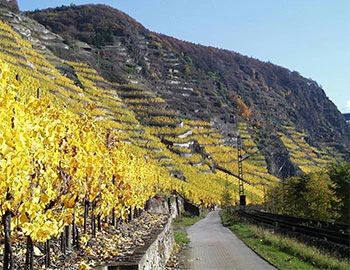Roter Satz 2015
QbA Pfalz, Rings, 750 ml

| Grape variety: | Portugieser, Sankt Laurent, Dornfelder, Cabernet Sauvignon |
| Producer: | Rings |
| Origin: | Germany / Pfalz |
Description
A ripe nose of sour cherries and dark berries. Subtle pepper notes. Very juicy on the palate with soft tannins and a balanced acidity.
Attributes
| Origin: | Germany / Pfalz |
| Grape variety: | Portugieser, Sankt Laurent, Dornfelder, Cabernet Sauvignon |
| Label: | Vegan |
| Ripening potential: | 1 to 5 years |
| Drinking temperature: | 16 to 18 °C |
| Food Pairing: | Italian antipasti, Apéro riche, Roast veal with morel sauce, Crispy roast chicken, Pork fillet with plums |
| Vinification: | fermentation in wooden barrel |
| Harvest: | hand-picking with simultaneous grape sel, strict selection |
| Maturation: | in large wooden barrel/foudre |
| Maturation duration: | 11 months |
| Volume: | 13.0 % |
| Note: | Contains sulphites |
Dornfelder
The reliable German Growth
This red grape is the most successful German new variety. The Dornfelder was created in 1955 at the State Institute and Research Station for Fruit and Wine Growing in Weinsberg by crossing the Helfensteiner and the Heroldrebe. The variety got its name from Immanuel Dornfeld, who founded the wine school in the 19th century.
Since then, Dornfelder has spread far, as this vine demands little of the soil, matures reliably, and has large, high quality yields. In Germany, around 10% of vineyard area is planted with Dornfelder.
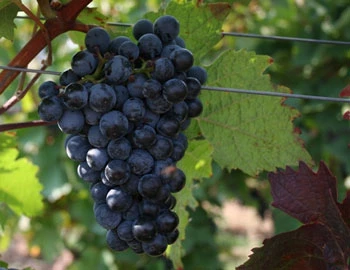
Portugieser
Historical, though shady
The source of this variety source is not entirely understood.
According to the story, these shimmering blue berries get their name because they found their way to Austria in 1772 from the historic Portuguese city of Porto.
Historical documents relate that “The Earl of Fries was the Austrian emissary in various countries, including in Portugal. He had vineyards on his property in Vöslau. In 1772, he brought varieties from abroad to Vöslau, allowing them to grow in his vineyard.”
Curiously, however, this vine is completely unknown in Portugal, and so it is suspected to have come from Austria or Hungary.
Portugieser is characterized by its low demands in terms of climate and soil conditions. It also reliably produces high yields. Planted on around 4,500 hectares, this vine is one of the most important red wine grape varieties in Germany today.
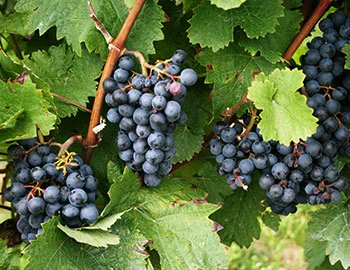
Sankt Laurent
The grape with the halo
The berries of the Saint Laurent fade from the tenth of August, St. Lawrence’s day, the patron saint of chefs. In its homeland in Austria, the variety was formerly called Laurenzitraube. With its aroma of fresh sour cherries and elegant tannins, it appears to be a more powerful version of Pinot noir. However, the two are not related. The Saint Laurent is currently undergoing a boom. Its wines are deep-red, velvety, full-bodied and aromatic. Above all, the qualities from the oak barrels delight lovers of softer, fuller reds. Yet the largest cultivation area is not in Austria, but the Czech Republic. A little anecdote: the Saint Laurent lost its halo there during the Soviet era, and was allowed only to be called Vavrinecké instead of Svatovavrinecké.
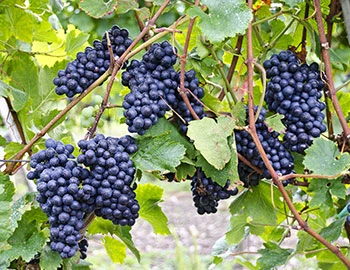
Cabernet Sauvignon
The backbone of Bordeaux
The Cabernet Sauvignon gives the Bordeaux its backbone, yielding deep violet wines with powerful tannins and endless ripening potential. It is the top dog in Médoc, and is placed in all five premier crus of Bordelais. When young, it often appears strict and unapproachable, but with advancing years, its tannins round off. It is wonderfully velvety, and yet always maintains its freshness. Typical flavours include cassis, graphite and cedar. Wherever Cabernet Sauvignon is found, Merlot is not far away. It complements the robust structure of Cabernet with softness, fruit and richness. The Cabernet Sauvignon is the most-exported vine in the world. It delivers persuasive qualities in Italy as an ingredient of the Super Tuscan, or as the flagship variety from California. There, it is lovingly titled “Cab Sauv”. Meat fans should be aware that it fantastically accompanies a grilled entrecôte. The family tree of Cabernet Sauvignon is surprising: its parents are Cabernet Franc and the white Sauvignon blanc.
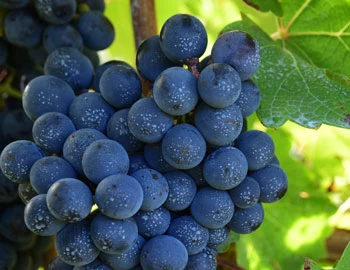
Germany
Germany – Into the elite the hard way
Sitting in the heart of Europe, the hilly, lake-dotted landscape of Germany provides ideal, fertile soil for the most diverse vine varieties. From Albalonga to Zweigelt, over 140 different grape varieties are grown on about 100,000 acres, cared for by nearly 50,000 vintners. Most of these vintners are young, modern, internationally trained, inquisitive and urbane. It is hardly surprising, then, that German wine has a good reputation well beyond the country's borders.
